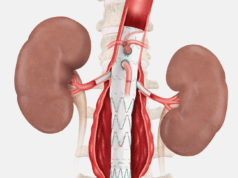
An investigation of differences in patient outcomes following open repair of abdominal aortic aneurysms (AAAs) found in three national registries showed that mortality rates were lower for those contained in the Vascular Quality Initiative (VQI).
Researchers at Brigham and Women’s Hospital in Boston discovered “fundamental differences” between patient profiles, payer mix and outcomes in the databases—differences in outcomes that persist “despite adjusting for these patient factors.”
The findings, presented during a rapid-fire session at the New England Society for Vascular Surgery (NESVS) virtual annual meeting (Sept. 11–12), were derived from a comparative analysis of open AAA repair outcomes across the three registries.
Large national databases are increasingly used to monitor adherence to quality benchmarks of care, presenter Rebecca E. Scully, MD, a vascular and endovascular surgery fellow at the institution, told the meeting. “However, wide variability has been previously demonstrated between various datasets.”
Using open AAA repair as a model, Scully et al identified individuals undergoing the procedure electively from 2013–2016 who were logged in the VQI, the American College of Surgeons National Surgical Quality Improvement Program (ACS NSQIP), and the National Inpatient Sample (NIS), a large publicly available all-payer inpatient database.
Key among their findings, Scully and colleagues discovered, were data related to mortality, which she said “varied significantly between groups.” They found in-hospital mortality of 3.3% in the VQI, 4.5% in NSQIP and 5.5% in NIS—differences that persisted at 30 days at 5% for NSQIP and 3.5% for the VQI. Meanwhile, she noted, the VQI was the only dataset that reported 90-day mortality, found to be 4.8%.
When adjusting for age, gender, race and comorbidities, the odds of inpatient mortality remained “significantly different,” with the higher odds reported among patients in the NIS and NSQIP datasets (NSQIP vs. VQI: odds ratio [OR] 1.5, 95% confidence interval [CI] 1.2–1.9; p=0.001. NIS vs. VQI: OR 1.8, 95% CI, 1.4–2.4; p<0.001), Scully said.
As well as mortality, the research team also looked at length of stay and discharge disposition outcomes.
In terms of baseline statistics, Scully reported significant differences in race distribution and primary insurer, with individuals in NIS more likely to have Medicare compared to the VQI. Additionally, the same was true of comorbidities across the three datasets, she said.
“We captured procedure-specific variables; however, availability of these data was limited primarily to the VQI, and serves to highlight that specific procedure data was not available in the NIS or NSQIP, including approach or clamp position,” Scully noted.
Length of stay varied from slightly over nine days in the VQI to 10-and-a-half days for patients captured in NSQIP (p=0.003). Disposition at discharge also varied between groups, with 76% of patients sent home in the VQ, and 73% in NIS and NSQIP (p<0.001).
Concluding, Scully said the differences the research team’s analysis detected may reflect the varying choices made by institutions over which quality improvement (QI) registries they participate in. “It’s crucial to take this into account when discussing policy decisions and national guidelines based on these data repositories.”
Scully went further during questions posed by session moderators Alan Dardik, MD, and Palma Shaw, MD. Dardik asked whether the better results shown in the VQI indicated more vascular surgeons using the database and therefore getting better results than other specialty surgeons commonly represented in other registries.
“Part of it is NIS is a completely administrative dataset and the VQI and NSQIP are QI databases, so we decided to focus on inpatient mortality as a pretty binary outcome,” Scully answered. “Part of it is differences between the two populations, within the populations captured in the NIS and captured in the VQI and NSQIP, and I think part of it is differences in institutions that have elected to be part of the VQI compared to NIS, which is a national sample.”
Meanwhile, Shaw wondered whether the research suggested a need for one unified database, adding that the VQI seemed more complete. “[The VQI] has expanded and continues to expand,” Scully responded. “Participation in QI registries like the VQI that capture more granular data would I think allow for—based on these data—potentially better care to be delivered to patients.”












